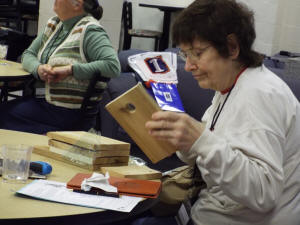|
Second session breakouts offer:
Coleus, easy to grow, many color choices,
easy to propagate,' 'Make and take wren houses and wren care,' or
'Creating a Pollinator Pocket for insects'
 Send a link to a friend
Send a link to a friend
[March 19, 2018]
LINCOLN
- Charlotte Talkington provided a workshop on growing coleus from
seed, and utilizing the plants in the summer landscape. Guests to
this session learned about the different varieties of the plant, and
also how to start them from seed inside. Talkington explained that
coleus can be overwintered inside.
|
|


Attendees at this session also enjoyed learning how to make newpaper
planters for seed. Talkington led a step-by-step demonstration while
guests followed along with their own newspaper pieces.


Local
Master Gardener Jim Struebing led a discussion on wrens. Attendees
at the Build a Wren House Workshop were led in the construction of a
make and take wren house for their own back yard.
Guests not only made their own house, but were given advice on where
to place the house in their yard, and when and when NOT to open the
boxes. Streubing explained that the wren carries lice and also that
the houses can get quite stinky with bird waste, so it is not
advisable that one peeks inside during the habitation season.
However, he said when the wrens have moved on, the wren houses
should be cleaned out and made tidy for the next guests.
Creating a Pollinator Pocket for insects

The
third breakout of session two was led by Jennifer Fishburn,
Horticulture Educator for the University of Illinois Extension.
Fishburn provides education services in the local district that
includes Logan, Menard, and Sangamon Counties. Her talk was on
creating a Pollinator Pocket for insects in the home garden or
landscape.
[to top of second column] |


Fishburn
talked about the various insects that will utilize the pocket of
plants, and shared that honey bees are not native to the U.S. though
there are several varieties of bees that are. She also said that
bees ultimately do not want to sting because, the loss of their
stinger means the loss of life, so unless they are provoked or feel
threatened, they donít typically go about stinging people.

She shared information of having a bug house made from hallow reeds
of various sizes and said that such a house will be occupied by
bees, spiders, and other beneficial insects.

Speaking
about the Pollinator Pocket garden, she said that it was important
to let neighbors know why the patch is in the lawn. She said out in
the country, homeowners can do pretty much whatever they choose in
their landscapes, but in town and in area where there might be a
homeowners association, neighbors and city safety officials may see
the patch as nothing but unsightly weeds. She said it is good to
share with neighbors what the patch is about, and also putting a
small sign at the base of the bed designating it as a special garden
will help also. She said in addition, having the talks with
neighbors and providing the sign may encourage others to do the same
thing, thus making a community a haven for some very nice bugs.
Fishburn shared information and resources that are available through
the extension and also included a layout for a small pocket garden
that will benefit a wide variety of insects native to this area.
[Nila Smith] |